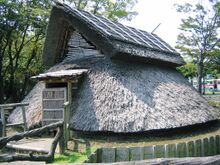Difference between revisions of "宀"
| (6 intermediate revisions by the same user not shown) | |||
| Line 4: | Line 4: | ||
[[宀]] ([[X5B80]]) is used in Chinese and Japanese languages. |
[[宀]] ([[X5B80]]) is used in Chinese and Japanese languages. |
||
<div style="float:right;margin:-2px -14px 0px 4px;"> |
<div style="float:right;margin:-2px -14px 0px 4px;"> |
||
| − | [[File:2004年08月25日竪02.JPG|220px]]<br><center>[[⼧]] or [[宀]]< |
+ | [[File:2004年08月25日竪02.JPG|220px]]<br><center>[[⼧]] or [[宀]] by <ref name="ja"> |
| + | https://ja.wikipedia.org/wiki/%E5%AE%80%E9%83%A8 |
||
| + | https://ja.wikipedia.org/wiki/宀部 |
||
| + | 宀部(べんぶ)は、漢字を部首により分類したグループの一つ。 |
||
| + | 康熙字典214部首では40番目に置かれる(3画の11番目)。 |
||
| + | 「宀」の字は交差して覆う屋根を象り、家屋を意味する。 |
||
| + | 偏旁の意符では主に家屋や屋根の名称・家屋に関わる形容詞・動詞であることを示している。 |
||
| + | 宀部はこのような意符を構成要素とする漢字を分類している。 |
||
| + | </ref></center> |
||
</div> |
</div> |
||
| Line 41: | Line 49: | ||
==Phonetic== |
==Phonetic== |
||
| − | in [[Japanese]], character [[ |
+ | in [[Japanese]], character [[宀]] ([[X5B80]]) |
can be pronounced as |
can be pronounced as |
||
うかんむり (ukanmuri) |
うかんむり (ukanmuri) |
||
| Line 48: | Line 56: | ||
</ref> |
</ref> |
||
| − | Character [[⼧]] |
+ | Character [[⼧]] ([[X2F27]]) has similar pronunciation. |
==Semantic== |
==Semantic== |
||
| Line 64: | Line 72: | ||
</ref> |
</ref> |
||
| − | Character [[⼧]] |
+ | Character [[⼧]] ([[X2F27]]) has similar meaning. |
| + | |||
| + | ==Automatic translations== |
||
| + | The automatic translators do not recognize symbols <br> |
||
| + | [[⼇]] ([[X2f07]]) nor <br> |
||
| + | [[宀]] ([[X5B80]]) nor <br> |
||
| + | [[うかんむり]]<br> |
||
| + | as elements any language that have any meaningful equivalent in any European language |
||
| + | <ref> |
||
| + | https://translate.google.com/?sl=ja&tl=en&text=%E2%BC%A7%E5%AE%80%0A%E5%AE%80%E9%83%A8%0A%E5%AE%80%E9%83%A8%0A%E5%AE%80%0A%E3%81%86%E3%81%8B%E3%82%93%E3%82%80%E3%82%8A&op=translate |
||
| + | </ref><ref> |
||
| + | https://www.deepl.com/translator#ja/en/%E2%BC%A7%E5%AE%80%0A%E5%AE%80%E9%83%A8%0A%E5%AE%80%E9%83%A8%0A%E5%AE%80%0A%E3%81%86%E3%81%8B%E3%82%93%E3%82%80%E3%82%8A |
||
| + | </ref> |
||
==References== |
==References== |
||
| Line 73: | Line 93: | ||
[[Chinese]], |
[[Chinese]], |
||
[[Japanese]], |
[[Japanese]], |
||
| − | [[ |
+ | [[Kanji]], |
[[KanjiLiberal]], |
[[KanjiLiberal]], |
||
[[KanjiRadical]], |
[[KanjiRadical]], |
||
| Line 82: | Line 102: | ||
[[Category:Chinese]], |
[[Category:Chinese]], |
||
[[Category:Japanese]] |
[[Category:Japanese]] |
||
| − | [[Category: |
+ | [[Category:Kanji]] |
[[Category:KanjiLiberal]] |
[[Category:KanjiLiberal]] |
||
[[Category:Unicode]] |
[[Category:Unicode]] |
||
Latest revision as of 07:46, 3 June 2021
宀 (X5B80) is Unicode character number 31348, qualified as KanjiLiberal.
宀 (X5B80) is used in Chinese and Japanese languages.
⼧ and 宀
The KanjiRadical character ⼧ (X2F27) can be confused with the KanjiLiberal character 宀 (X5B80). Even native Japanese speaker, looking at ⼧ and 宀, may have difficulties guessing, which of them is X2F27 and which is X5B80.
This confusion can be resolved with command
php du.t ⼧宀
where du.t is PHP program that should be loaded for the execution. The output is
⼧宀
The array has 6 bytes; here is its splitting:
e2 bc a7 e5 ae 80
array(2) {
[0]=>
string(3) "⼧"
[1]=>
string(3) "宀"
}
Unicode character number 12071 id est, X2F27
Picture: ⼧ ; uses 3 bytes. These bytes are:
xE2 xBC xA7 in the hexadecimal representation and
226 188 167 in the decimal representation
Unicode character number 23424 id est, X5B80
Picture: 宀 ; uses 3 bytes. These bytes are:
xE5 xAE x80 in the hexadecimal representation and
229 174 128 in the decimal representation
Phonetic
in Japanese, character 宀 (X5B80) can be pronounced as うかんむり (ukanmuri) [2]
Character ⼧ (X2F27) has similar pronunciation.
Semantic
character 宀 (X5B80) may denote "roof", part of a building that protects its top part from the rain and/or snow. [3]
Character ⼧ (X2F27) has similar meaning.
Automatic translations
The automatic translators do not recognize symbols
⼇ (X2f07) nor
宀 (X5B80) nor
うかんむり
as elements any language that have any meaningful equivalent in any European language
[4][5]
References
- ↑ https://ja.wikipedia.org/wiki/%E5%AE%80%E9%83%A8 https://ja.wikipedia.org/wiki/宀部 宀部(べんぶ)は、漢字を部首により分類したグループの一つ。 康熙字典214部首では40番目に置かれる(3画の11番目)。 「宀」の字は交差して覆う屋根を象り、家屋を意味する。 偏旁の意符では主に家屋や屋根の名称・家屋に関わる形容詞・動詞であることを示している。 宀部はこのような意符を構成要素とする漢字を分類している。
- ↑ https://translate.google.com/?sl=ja&tl=en&text=%E5%AE%80&op=translate
- ↑ https://ja.wikipedia.org/wiki/%E5%AE%80%E9%83%A8 https://ja.wikipedia.org/wiki/宀部 宀部(べんぶ)は、漢字を部首により分類したグループの一つ。 康熙字典214部首では40番目に置かれる(3画の11番目)。 「宀」の字は交差して覆う屋根を象り、家屋を意味する。 偏旁の意符では主に家屋や屋根の名称・家屋に関わる形容詞・動詞であることを示している。 宀部はこのような意符を構成要素とする漢字を分類している。
- ↑ https://translate.google.com/?sl=ja&tl=en&text=%E2%BC%A7%E5%AE%80%0A%E5%AE%80%E9%83%A8%0A%E5%AE%80%E9%83%A8%0A%E5%AE%80%0A%E3%81%86%E3%81%8B%E3%82%93%E3%82%80%E3%82%8A&op=translate
- ↑ https://www.deepl.com/translator#ja/en/%E2%BC%A7%E5%AE%80%0A%E5%AE%80%E9%83%A8%0A%E5%AE%80%E9%83%A8%0A%E5%AE%80%0A%E3%81%86%E3%81%8B%E3%82%93%E3%82%80%E3%82%8A
Keywords
Chinese, Japanese, Kanji, KanjiLiberal, KanjiRadical, Unicode, UtfH,
